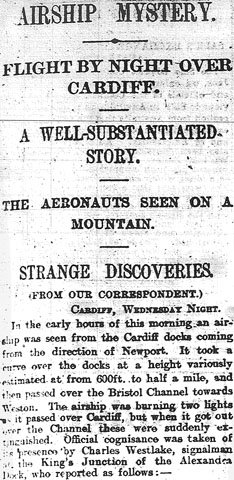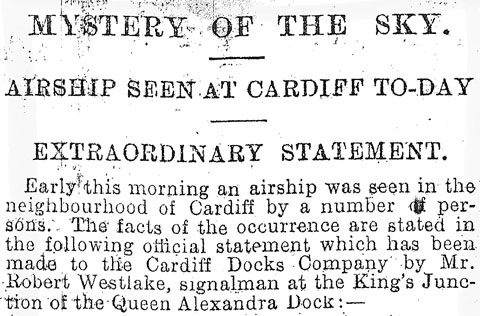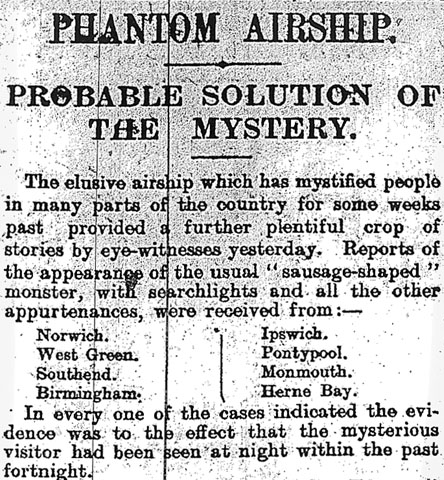
The Globe has a slew of new reports from last night (p. 7), from Norwich, Wroxham, Sprowston, Catton and Tesburgh in East Anglia, Pontypool in Wales (by workers at a forge, an architect and two postal workers), and Kingstown (now Dún Laoghaire) in Ireland. Some saw searchlights, some heard a ‘whizzing’ sound, some saw a cigar shape. But yesterday’s story of the airship seen at Cardiff, is today the main scareship story in both the Standard and the Manchester Guardian, as well as (again) the Globe. It’s clear that the mystery airships have moved from a minor curiosity to, if not big news, exactly, then at least middling news. The Globe has nearly a whole column on them, the Standard has another column, and the Manchester Guardian — which has mostly ignored the story up until now — has two full columns (see headlines above), a comment from its London correspondent and a leading article on ‘The mysterious airship’. The only holdout in my sample is the stuffy old Times.
The Cardiff docks story is the lead. The statement of the signalman Charles Westlake is repeated, and further supporting statements from the other dock workers given. The Manchester Guardian‘s correspondent reports a rumour (p. 7) that residents of the Cathays district of Cardiff saw an airship on Tuesday night (i.e. the evening before the dock incident) but has not been able to verify this. It is also pointed out that locals are familiar with the appearance of airships, because one was built and flown nearby several years ago. This would be Willows No. 1; but it seems that Willows is not responsible for the mystery airship. At least, ‘a Cardiff man, who has made a study of aerial navigation for many years past, and whose son is at present in London exhibiting a dirigible airship’ is interviewed as well, without any connection being made between the two. But this must be Joseph Thompson Willows and his son Ernest Thompson Willows, who worked together on airships, though it is the son who is mostly remembered for this nowadays. In the opinion of Willows père, the airship at Cardiff was most likely launched from a ship in the Bristol Channel or off the south coast. He doesn’t say anything about who would be doing this, or why, but other locals seem to have their suspicions:
Naturally enough, tremendous interest has been manifested throughout the district, and in some quarters a feeling of unrest has been created, because it is generally recognised that in the event of invasion the Welsh coal ports would represent a vital spot of enormous strategical importance.
But there’s an even more sensational airship story from Cardiff. In fact, it is ‘of so strange a character as to be difficult of credence’, according to the Standard (p. 10). On the same night as the dockyard sighting, a travelling Punch-and-Judy salesman by the name of Lethbridge was walking back home from Senghenydd to Cardiff over Caerphilly Mountain. At about 11pm he saw an airship which had landed on the mountain, and its crew. At least, that seems to be the implication of the interview he gave to the Cardiff Evening Express yesterday.
At the mountain’s peak, he saw ‘a long, tube-shaped affair lying on the grass on the roadside, with two men busily engaged with something near by’. The men wore ‘big, heavy, fur coats, and fur caps fitting tightly over their heads’. When he got within twenty yards ‘they jumped up and jabbered furiously to each other in a strange lingo — Welsh, or something else; it was certainly not English’. They picked up something from the ground, and the object started to rise into the air. The men then ‘jumped into a kind of little carriage suspended from it’, with wheels. Once it had cleared some telegraph lines, it turned on two lights and headed towards Cardiff. Lethbridge took a journalist to the place where he had seen the airship; although the ground was hard there were signs of a disturbance, as though ‘a ploughshare or some such hard contrivance had been drawn across it’. The showman estimated that the airship had been 45 feet long. Nearby they found ‘a red label attached to a chain and small plug’; the label was in French and referred to the use of a tire valve. (This is reminiscent of the strange object found by the cliffside at Clacton: today the Standard reports that the War Office has impounded it, presumably for further study.) The Manchester Guardian has details (p. 7) of some papers found at the site. One bore the letterhead of a London stockbrokers, cut in half. On the lower portion were faint traces of some typed words: ‘provincial centres’, ‘rest assured that we shall not’, ‘the fullest confidence’, ‘this letter simply justified’. The Manchester Guardian concludes that ‘Whatever kind of ink was used for this letter it certainly is not of an indelible nature’. There were also scraps of newspapers, nearly all of which contain references on airships or the German army. And small pieces of blue paper, with numbers and letters written on them ‘in a style distinctly different to that of the average English hand’. Some ‘pulpy paper […] not very dissimilar from the appearance of a cartridge wad’. Finally, an empty tin of metal polish.
Whatever the explanation of these finds may be, there appears to be absolutely no reason to dismiss lightly the story of Mr. Lethbridge.
This sounds almost as if the Manchester Guardian is taking a position on the reality and perhaps the identity of the scareship (or scareships, if the one at Cardiff is not the same as the one in East Anglia). But its second leading article today (p. 6, following one on the Russian menace to Persia) is a little more sceptical:
All that can be said is that if there is an airship capable of sailing all over England at night, lying hidden in the daytime, and ascending from a lonely moor before an astonished Punch and Judy man who comes across it summons up the courage to address the crew (either Welshmen or foreigners, apparently, by their speech) it is the most wonderful in existence. And the wonder is increased if it is in reality only 45ft. long (most airships are as long as an Atlantic liner), as the Cardiff man says who met it. Being so wonderful and uncanny, it goes without saying that, in these days, it is believed to be a malignant German. Yet apparently it carries a plug with a label attached giving directions in French.
Such a plug could have come from an internal combustion engine, perhaps from a motor car, perhaps from an airship. Even the most ‘patriotic’ German might use a French engine, but it’s more likely that a Frenchman or Englishman would. Summing up, the leader writer admits that
There is a great deal of evidence for the existence of this airship, and we are in great hopes that the owners may, after all, be Englishmen — not of the War Office, for we have almost given up hope of airships from there, but ingenious inventors experimenting in secret with a wonderful airship that is destined to beat all rivals.
So the Manchester Guardian has gone from ignoring the phantom airships to something close to believing in them. It has some reservations, encapsulated in the headline to its summary of the sightings to date: ‘The gathering cloud of rumour’ (p. 7). And unlike the Standard and the Globe it scoffs at the idea of a German origin for it. This is the difference between liberal and conservative views of the mystery airships.
According to a statement published in the Globe (p. 7), Harold Perrin, Secretary of the Aero Club, agrees with the Manchester Guardian that if the airship exists it must be a powerful machine:
“If the reports are true,” said Mr. Perrin, “all I can say is that it must be a jolly good machine. I take it that it is a dirigible airship, and from the way it is reported to have been manipulated, it appears to be a far better machine than anything we have yet publicly heard of.”
Powerful enough to have flown from Germany? Not according to reports from Berlin (relayed via the Dail Mail), where suggestions that German airships are responsible for the sightings have met with ‘contempt and ridicule’. Strong east winds would have blown any airships ‘even of the most modern construction […] into the Atlantic’. Indeed, due to these hight winds no German airships have been operating in the last few days.
Somebody has a long (if imperfect) memory. The London correspondent of the Manchester Guardian notes (p. 6) that something similar has happened before: ‘in 1898 America had a very severe visitation of the same kind’. A letter to a ‘Chicago journal’ told of a ‘cigar-shaped balloon with a long car, lit up like a liner, and travelling very fast’, seen late at night. After this letter was published, similar stories poured in from all across the United States. It then turned out that the first letter was a hoax, but that the subsequent letter-writers believed they had seen something. This is a garbled account of the mystery airship sightings of 1896 and 1897, but it suggests that the London correspondent had in mind some sort of mass delusion or suggestion as the cause of the scareships.
Finally, a followup on Sir John Barlow’s parliamentary question about the 66000 German soldiers rumoured to be in England. Haldane, the Secretary for War, yesterday supplied the following written answer (Manchester Guardian, p. 9):
How many German army reservists reside in England I do not know, probably a large number. Only a person devoid of even the elements of military knowledge would suggest that they can constitute an organised force, or that mobilisation arrangements can be made for them, including the storage of the requisite arms and ammunition and other necessary articles, without the knowledge of those authorities for dealing with such matters. The statement to which my hon. friend alludes is an exceptionally foolish one.
So that’s that then!
![]() This work is licensed under a Creative Commons Attribution-NonCommercial-NoDerivatives 4.0 International License.
Permissions beyond the scope of this license may be available at http://airminded.org/copyright/.
This work is licensed under a Creative Commons Attribution-NonCommercial-NoDerivatives 4.0 International License.
Permissions beyond the scope of this license may be available at http://airminded.org/copyright/.




Pingback: Airminded · Friday, 21 May 1909
“The statement is… an exceptionally foolish one.” If only Lord Haldane had lived to see the Internet –telegraph networks aside.
And it seems that Liberals believe in some private inventive genius (no doubt a Nonconformist, his mind untrammeled by Established church schools), while Conservatives believe in German scientific efficiency. Which is interesting, because insofar as I get this, the whole “German efficiency” thing is also part of the mid-nineteenth century progressive critique, Low Church brand as opposed to Nonconformist.
Analyzing this as political evolution on the British Right, it is disappointing to see the way that xenophobia leads former Disraelites towards Thatcherism, where Correlli Barnett can emerge as the mass retailer of obsolete Radicalism and imagine himself a conservative ideologue.
It seems to me that the idea of ‘German efficiency’ was employed by both Liberals and Conservatives to suit their favoured causes: tariff reform, conscription, navalism on the one hand, education reform, welfare reform on the other. Here the possibility of an efficient German airship wasn’t appealing to Radicals because it bolstered the case for increased military expenditure and hence went against disarmament and retrenchment.
Brett, the thing about ‘German efficiency,’ and I admit that I might be stretching, is that I see it ultimately coming out of the Prussian “coordination” of the Lutheran and Reformed churches in 1819. I’m saying that that looks like a model to the Anglican Left (Broad Church, Low Church, whatever), and sort of hardens into a wide critique of British society, since practically anything the church does, must be done better in Prussia/Germany on account of its more advanced state church.
So the whole idea of comparing Britain to Germany (and the United States), has a great deal to do with left ecclesiastical politics to start with.
Thanks, I can see where you’re coming from now. But then why didn’t High Church Anglicans/Anglo-Catholics start a competing movement to emulate the Italian state?
Pingback: Airminded · Post-blogging the 1909 scareships: thoughts and conclusions
Pingback: Airminded · The last flight of the Patrie